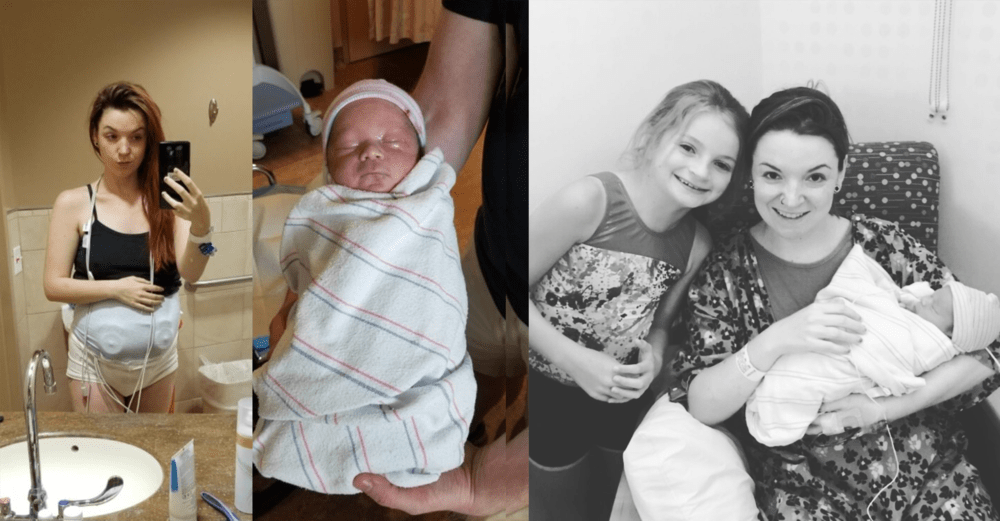Janine’s Birth Story
Retrospect is a wonderful vantage point. So wonderful, in fact, it should be made into a vacation spot. Looking back, I should have followed my intuition. But, instead, I kept remembering my mother’s bladder control problems after multiple pregnancies. It was a Saturday afternoon when I first thought I was losing bladder control. It was so slight I didn’t think much of it. Being a responsible adult, I made sure to use the restroom at regular intervals, especially at even the hint of a filling bladder. Saturday continued with very little accidents. The following day is when intuition was trying to grab my attention. The accidents became a little less … well, little. A vague contemplation of amniotic fluid vs. urine entered my head. My experience wasn’t reflective of my last two pregnancies, which only left me further unsure. Luckily, I had an appointment the next morning and would have definitive proof as to whether my age was showing or my water was leaking.
Monday morning, at 34 wks pregnant, I was given confirmation that the fluid was in fact amniotic fluid. An ultrasound was ordered immediately, at which point I also started having very attention-grabbing contractions. And while it wasn’t a surprise, I still let out a small gasp when the nurse said, “I’m sorry honey, you’re going to be here until that little boy comes out.” I handled the information remarkably well, in my opinion. Until it came time to let the parents know and make arrangements for my daughter’s care. Then reality settled, along with the waterworks. By the grace of the universe, the parents took it very well and my daughter’s care was finalized in less than an hour.
There were two events that we would be awaiting, and whichever occurred first would be when the baby would come. Ideally, I would be kept on strict bedrest until 37 wks pregnant, at which point I would be induced. Should my body and the baby have other plans, as they so often do, we would let nature take its course without intervention. I made it ten days before the baby’s heart rate and my rising temperature became a concern. So, at 35 wks and 4 days, I was induced. I called the parents and let them know it was time to make their way south. I also called my dear friend who would be my support during labor and delivery.
For anyone who has ever been induced, I feel confident saying we all know there is a vast difference between normal contractions and Pitocin contractions. Using my previous surrogacy pregnancy and induction as a guide, I decided to get an epidural. Later, we will come to learn another vital reason an epidural was needed. The parents and my friend arrived shortly before midnight. During the course of the night, little to no progress was made in the dilation of my cervix. My nurse informed me that oftentimes dilation is difficult after a cone biopsy because of the scar tissue that builds up. This was new information to me, which prompted the question, “So what do we do?” Having experience with this situation, my nurse attempted to stretch my cervix. An hour later, the on-call OB contacted my nurse for an update. Shortly after, the OB came to share her concerns.
“I’ve worked with your doctor for several years. Because I know him so well I can say with complete confidence that if we don’t get your labor to progress he will do a c-section.” I had no intentions of having surgery if there was another solution, so I asked her to do whatever was within her power to get things moving. Similar to what my nurse did, the on-call OB manually stretched my cervix, but with much more motivation and determination. Then there was an audible snap.
“It’s a good thing you got that epidural, because you would not have been able to tolerate what I just did.” Thank God for modern medicine! From this point my nurse and I worked together to alternate positions to stimulate progression. At 8:30am, with no changes visibly on the horizon, the parents stepped out to grab breakfast from the hospital cafeteria. A few minutes later, I decided I would try laying on my right side. After hours of feeling nothing, I felt a contraction. A STRONG contraction. I breathed deeply and ignorantly stated, “I don’t think this is a good position. Let me feel it out because I feel another contraction coming on.”
The next contraction was on par with what it felt like minutes before I had my own daughter 9 years ago. Then, not more than 30 seconds later, I bellowed, “His head is coming out!!!”
The nurse must have thought it was too quick of a change for the baby to be crowning, because she reassured me it must be an immense amount of pressure, not the baby coming. But all it took was a quick glance under the sheet to confirm what I was certain of.
“Don’t push! Breathe through the pain honey, you got this.” I don’t know if you have ever been asked to breathe through a human being trying to exit your body, but it is a tall order. Your body is magical and wants to complete what it’s designed to do. Breathing through a contraction and not pushing oscillates between being the hardest thing I’ve ever done and impossible. Sometimes I could do it, sometimes I pushed because my body wouldn’t allow me not to. Why couldn’t I push? We were waiting for my OB to arrive and everyone was trying to track down the parents. To be fair, the situation went from twiddling thumbs and actively trying to prevent a birth in under 90 seconds.
The hospital staff did an emergency page for the parents and much to my shock, I had to type in my password to my phone during a contraction so my friend could call them directly. Again, if you’ve ever tried entering a password while actively trying to keep a baby from being born …
I must have shut my eyes for the remainder of the battle because as soon as I heard my OB’s voice I yelled, “CAN I PUSH???” There was a collective “yes” from everyone in the room. 30 seconds later, the baby boy I had so desperately tried to keep in for 12 days finally made his entrance into the world.
I don’t remember much immediately following his delivery because I felt the need to keep my eyes shut for an extended period of time. After my body calmed down, I coyly peaked up to see both parents staring adoringly at their little boy. Unexpectedly, I began to cry. Feeling the need to make sense of my emotional state, I said out loud, “This is so different than last time. Last time I was helping complete a family. This time, I helped start a family.” With tears in his eyes, one of the fathers replied, “Thank you so much for what you have given us.”
The rest of the story is fairly “normal.” I stayed in the hospital 2 extra days to receive antibiotics to ensure my rising temperature wasn’t the start of an infection. My beautifully perfect belly buddy was discharged the next day in perfect health. Despite being born 4 wks early, he scored perfectly on all tests and showed no signs of deficiency. My daughter finally got to meet the little soul she had been giving life lessons to via belly pep talks (“You can be whatever you want to be when you grow up. If you want to be a boy ballerina, you can be! Just make sure you’re nice to people, the rest doesn’t matter”). Surrogacy has been a selfish endeavor for me because the joy I have felt helping others can’t be replicated. And the ways I’ve grown as a person and mother wouldn’t have been possible without these journeys. Surrogacy is not for the faint of heart. But if you find the courage to give so selflessly, the rewards outweigh anything your mind can imagine.














